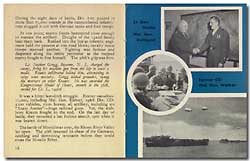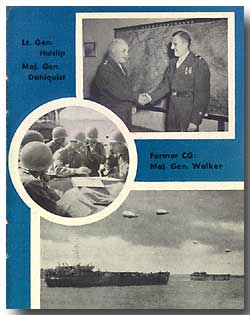

Pages 16 and
Insert
During the eight days of battle, Div Arty poured in more than 75,000 rounds as the outnumbered infantrymen slugged it out with German tanks and foot troops.
 At
one point, enemy forces hammered close enough to menace the artillery.
Doughs of the 142nd barely beat them back. Rushed into the line as
infantry, engineers held the panzers at one road block; cavalry recon
troops manned another. Fighting was furious and desperate along the entire
perimeter as the trapped enemy fought to free himself. The 36th’s grip
was firm.
At
one point, enemy forces hammered close enough to menace the artillery.
Doughs of the 142nd barely beat them back. Rushed into the line as
infantry, engineers held the panzers at one road block; cavalry recon
troops manned another. Fighting was furious and desperate along the entire
perimeter as the trapped enemy fought to free himself. The 36th’s grip
was firm.
Lt.
Stephen Gregg, Bayonne, N.J., charged the enemy, firing his machine gun
from the hip to cover a medic. Krauts infiltrated behind him, attempting
to seize some mortars. Gregg lobbed grenades, swung the mortars on other
Krauts. He was awarded the Congressional Medal of Honor, seventh in the
36th, second for Co. L, 143rd.
It was a bitter last-ditch struggle. Enemy casualties: 11,000, including Maj. Gen. Richter, 198th Div. CO; 2100 vehicles, 1100 horses, all artillery, including six “Anzio Annies” — huge railroad guns. Yet, the stubborn Krauts fought to the end. On the last day of battle, they mounted a last furious assault, quit when it was beaten down.
The battle of Montelimar over, the Rhone River Valley lay open. The 36th resumed its chase of the Germans, catching and destroying remnants before they could cross the Moselle River.
Copyright © 2000
All Rights Reserved
This World War II history
is sponsored and maintained
by TMFM